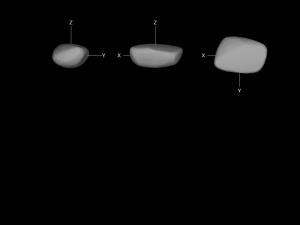![A 3D shape model of the asteroid 2012 TC4. [사진=한국천문연구원]](https://i0.wp.com/cdn.enewstoday.co.kr/news/photo/202103/1461470_519308_257.jpg?w=560)
[이뉴스투데이 전한울 기자] On the 18th, a joint research team of the Korea Astronomical Research Institute (Astronomical Research Institute) and Karel University in the Czech Republic discovered a new fact that TC4’s rotation cycle was accelerated by capturing the unusual non-spindle rotational motion of the asteroid 2012 TC4 and analyzing the observational data. Revealed.
The non-main shaft rotational motion refers to the rotational motion in which the top rotates as if it twists and rotates just before it collapses, and the precession in which the rotational axis rotates occurs at the same time.
Asteroids are mainly small objects in the solar system located in the asteroid belt orbiting between Mars and Jupiter orbits. The asteroid TC4 reached a distance of about 95,000 km and 50,000 km from Earth in 2012 and 2017, respectively. The International Asteroid Alert Network and Astronomical Yeongyeon promoted a joint observation campaign for the asteroid TC4, and 21 astronomical observatories around the world participated to track the change in brightness of TC4.
By analyzing this observational data, a joint research team at Cheon Mun-Yeon-Carel University implemented a 3D shape model of TC4.As a result, it was found that the rotation speed of TC4 was increased by 18 seconds in 5 years from 2012 to 2017.
Asteroids do not emit light on their own and reflect only a portion of sunlight, and their small size has many limitations in direct observation and research. The researchers implemented a 3D model by inverting the change in brightness that appears as TC4 rotates and reflects sunlight, and through this, it revealed that TC4 is a non-main axis rotating asteroid.
In addition, as a result of the calculation by assuming various internal and external factors applied to the asteroid, it was revealed that the main reason for the change in the rotational state of TC4 was due to the Yoph effect of the asteroid’s absorption and re-emission of solar energy.
Dr. Hee-Jae Cheon, who led this study, said, “The study on the characteristics of near-Earth asteroids and the Yope effect is very important for early detection of asteroids with high potential for Earth impact and to find out their precise trajectory.” “We have actually confirmed the change in rotation of the asteroid and will greatly contribute to predicting the risk of asteroid impact on Earth in the future.”
Moon-Yeon Cheon is planning a direct exploration mission for another asteroid Apopis, which rotates non-axis. Apophis is expected to pass 31,000 kilometers above the surface on April 14, 2029.
Apophis is also predicted to change its rotation characteristics under the influence of the tidal forces caused by the Earth. Moonyeon Cheon plans to use the results of this study in planning future Apophis exploration missions.
Meanwhile, the results of this study were published in the February 11th issue of the Astronomical Journal of the American Astronomical Society.
Copyright © Enews Today Unauthorized reproduction and redistribution are prohibited.
